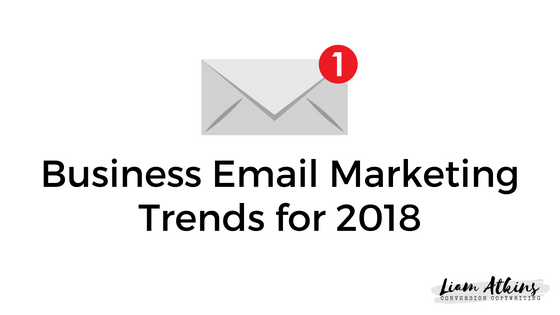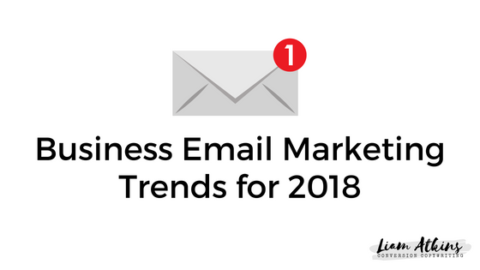
Too many wannabe ‘guuurooos’ will claim that email is dead.
That it no longer works, is out of style or somehow too old-fashioned compared to the whizz bang shiny shit.
Yep, it’s not exactly a Snapchat message, so for some it is considered old-fashioned.
However, email marketing is every bit as relevant today as it has ever been. All the email marketing statistics suggest that it is responsible for driving some of the highest conversions of all forms of online marketing.
One of the best things about this form of marketing is the fact that you’re able to quickly and easily communicate with your audience directly – getting your messages directly to them, and often on their phone.
A captive audience, in their pocket.
Coupled with marketing automation and segmentation, internet marketers are able to send email messages out which are hyper targeted at the touch of a button.
So, time dive straight in.
Let’s take a look at some trends shaping the email marketing industry in 2018.
Trend 1: Targeting and Cross-Channel Tracking
One of the greatest challenges facing those who use email marketing is the fact that consumers use so many different and unique types of devices.
Plus, there is the challenge of tracing consumers that click through a link in the email on a mobile device, then go on to use their tablet later on when making the purchase.
There is the difficult to answer question whether or not this type of activity can be properly tracked. And to complicate matters even further, what if it’s a shared device?
With tracking and analytical tools getting better with each passing day, marketers are benefiting by being able to combine data across all the different sources.
However, all that said, the capability to track is only as good as the ability one has to effectively make use of it. For this reason, many email marketing software vendors are now allowing it’s users to set up intricate automation rules that lead to being able to keep track of email subscribers on virtually any device being used.
Trend 2: More Regulation
Regulations have long been a huge concern for email marketers.
You’ll already find strict rules, which can result in a significant fine from the Federal Trade Commission if you don’t comply with all of them.
(Let’s not get started with the new GDPR rules!)
Due to the volatile condition of global politics as well as ever-increasing concentration on Internet privacy, we’ll continually see efforts to introduce new guidelines.
The single best way to stay within the guidelines is to employ the double opt-in strategy when building an email list. While this will most certainly lead to receiving fewer sign-ups overall, it will keep you safely within the guidelines of the law.
Regulations don’t have to be something you see as bad though. As someone running a business if you put the needs of your customers first you won’t have any problems since this is how most of the regulations are designed and written.
The important thing is to give subscribers options about the data they provide and let them know exactly how you intend to keep and use their data.
Trend 3: Better and More Efficient CTA (Calls-To-Action)
Gone are the days when a simple call to action calling for users to sign up to get a newsletter would be enough for the emails to pour in.
These days’ users are much more sophisticated and have no interest in another ’empty’ newsletter. In all reality, the newsletter as we knew it 10 or 15 years ago is all but dead. Just like the generally un-targeted email blasts.
Smart email marketers have made the shift from these methods to automated list segmentation and personalization. This is a shift we will more than likely continue to see, and because of it, calls-to-action will continue to change as well.
In order to be successful calls-to-action will have to offer visitors something of value that they will gladly exchange with email marketers for their email address.
Trend 4: Speaking Directly To Subscribers
While most internet marketers still don’t view marketing through email as a way to have an open dialogue with customers the reality is, it’s a great way to create and build customer relationships.
At its simplest level, people are able to easily respond to your messages with their own views and comments, however, you might also create organized promotions that connect customers to live discussion widgets, online surveys, and other specific tools with email.
This serves as a very convenient way for businesses to be made aware of any issues with customer service that may crop up – immediately.
Of course, it’s also just plain good for business to communicate with customers occasionally – duh!?
These opportunities to communicate can yield some of the best feedback that will ever be received, which leads to better products and services.
Recent surveys have concluded that the more engaged a customer is with a particular business the longer they remain as a customer, and more than 50% of all customers don’t mind paying more if their experience with your organisation is good.
You really should be using email as part of your customer engagement strategy.
Trend 5: Shrink Those Emails
There is simply no disputing the fact that the rise of tablet and mobile use has had, and will continue to have, a noticeable effect on the way online marketing is done.
One of the biggest changes that can be readily noticed is the reduction in the size of emails. This is mainly in response to the rise of mobile users and the way they check their email while on the move.
According to recent surveys, the optimum length for an effective email message is around 60 and 120 words. Any shorter and they are perceived as not being valuable, and when they go longer than 120 words users tend to swipe past them. When considering the size of your email messages you must also factor in the images you include as well.
This shrinking of email is a trend that is sure to continue as we go forward, as the shorter quickly digestible content is becoming more and more popular. Online marketers must adapt to these trends in customer desires.
Where do we go from here?
As you can see, there is still plenty of room for email marketing even today. Due to the fact that email lists are the property of each individual business, email marketing remains at the top of any list of the best online marketing methods.
One trend currently taking hold is for email marketers to send more email messages, however, make them shorter and send in smaller more targeted batches.
From the looks of it, even though laws will certainly be introduced that will call for adjustments in the way it’s done, email marketing is not going anywhere any time soon.

